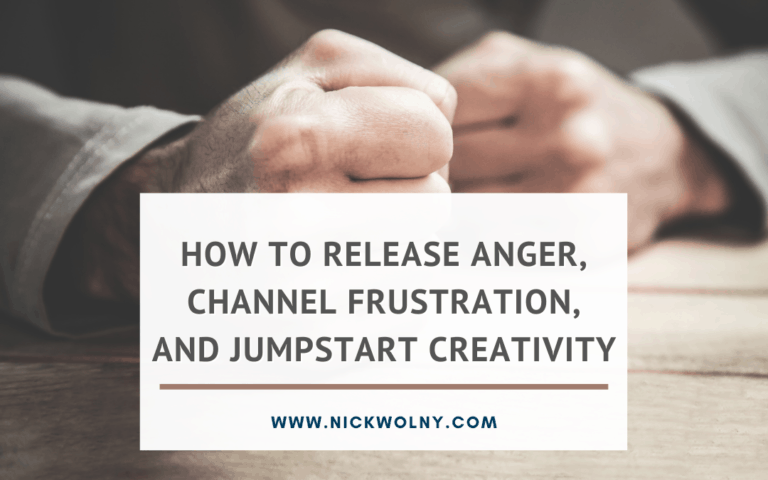HOW TO RELEASE ANGER, CHANNEL FRUSTRATION, AND JUMPSTART CREATIVITY

A version of this article was originally written for Fast Company.
Are you angry? Are you frustrated? You’re not alone; in fact, chances are you’re in the majority at the moment and you’re looking for ideas on how to release anger.
Springtime saw millions of workers terminated or furloughed as a cureless, rampant virus took hold. And now a surge of human rights injustices are compounding our anger and frustration, with virtual activism being one of our only safe outlets. (Did you belligerently unfriend half your Facebook connections from high school this last month? I did.) With no end in sight, there’s certainly a lot to be angry about.
From a young age, we’re not really taught how to release anger. Instead, we’re taught that anger is negative and an unproductive emotion that needs to be avoided altogether.
Anger doesn’t seem to fit in with the “pleasure principle,” our human instinct to seek positive feelings and avoid pain. To say that suffering and frustration are heightened at the moment is putting it lightly.
We should avoid being angry about it… right?
Maybe not. It all got me thinking about why anger seems to kick me into action. Yes, anger sucks – so why do I psych myself up during a workout with angry music and a self-directive to “get angry”? What is it about acting on anger that actually feels productive?

A quick brain lesson on anger
Researchers maintain there are two basic motivational forces that underlie human behavior: The impulse to approach something desired, and the impulse to withdraw or move away from something unpleasant. One would think anger would fall into the latter category and repel us, but recent science has actually overturned that view.
It turns out that anger significantly activates the left anterior cortex, a part of the brain crucial to establishing “approach” behaviors that push us to pursue desired goals. According to Dr. Neus Herrero from the University of Valencia in Spain, when humans get angry, we actually tend to get closer to the source of our anger rather than try to eliminate it.
In simpler terms, if you’re angry about something, your brain is wired to make you want to move toward the emotion and fully engulf yourself in it.
Release anger and encourage innovation
If you’re extra angry lately, I have even more good news: A 2014 study featured in Creativity and Innovation Management found that positive emotions actually constrain creative performance, whereas negative emotions can foster creative performance.
Anger can catalyze innovation, and many brilliant entrepreneurial ideas have been birthed from fury. Shark Tank mainstay Daymond John created fashion label FUBU (“For Us By Us”) in reaction to some larger brands that had sidelined his community. After a well-known boot company was quoted saying “We don’t sell our boots to drug dealers,” the seasoned shark took matters into his own hands; he launched his own brand rooted in inclusivity and pride, and FUBU turned over $350 million a year at its peak.
Tim Chen, CEO of NerdWallet, founded the company after being laid off in 2008 — “basically on Christmas day” as he tells it. And Chen is not the only entrepreneur to use the anger from being laid off as fuel to innovate; WhatsApp, Venmo, and Groupon were also products of the 2008 recession.
If you’re angry right now, the worst thing you can do is ignore it or try to suppress it. Instead, learn how to release anger and channel it into a productive and creative source. Better yet, use that productivity and creativity to address one of the problems our country is dealing with right now and invoke change. To quote Tom Peters, author of The Little BIG Things, “All innovation comes from fury.”
How to release anger
Now that we know anger can provide fuel for our creative fire, let’s channel its propensity toward something good rather than falling into another unproductive spiral. Here are a few tried-and-true ways to jumpstart your next brainstorm when anger’s at the helm.
Stream-of-consciousness writing
If you haven’t done the “Keep the pen moving” exercise since elementary school, now might be a good time to revisit this best practice for overcoming writer’s block. A common obstacle to creative thinking is that we’re censoring our thoughts and ideas from the start; idea generation is best served as a sloppy, unruly mess. Open up a new doc, set a timer, start writing, and don’t stop.
Feel especially stuck? Tinker with Squibly’s web-based Most Dangerous Writing App to override your synapses. This free website lets you assign a length of time (and a writing prompt if you want) to type about continuously. Here’s the catch: If you pause for more than five seconds, everything you’ve written will be erased. For those craving a pattern interrupt, this unorthodox approach may do the trick.
Sketchnoting
Why limit your creative thinking to words? Sketchnoting refers to information processing that incorporates shapes, arrows, containers, or other visual representations. Think whiteboard or tablet doodles.
As explained in Dr. Betty Edwards’ seminal book Drawing On The Right Side Of The Brain, verbal function and cognition reside mostly in the brain’s left hemisphere, whereas visual function is processed in the more dreamy right hemisphere. If you need to get your creative gears turning, sketchnoting possible solutions through conceptual shapes and structures may help unlock new and fresh ideas.
You’ll feel better, too. A study from Drexel University found this artistic approach also lights up the reward pathways in your brain, making you feel more inspired and accomplished.
Ultradian Rhythm
Similar to the circadian rhythm your body experiences each day, ultradian rhythm refers to the two-hour cycles of focus and rest our bodies repeat during both sleep and wakefulness. To use your time most constructively, look to concentrate in intervals of no more than 90 minutes, followed by a rest period of about 30 minutes.
These patterns were first discovered by sleep researchers Eugene Aserinsky, Nathaniel Kleitman, and William C. Dement in the 1950s when they discovered REM sleep. Their efforts focused on how the human body rested and recuperated; an additional revelation was that our energy systems follow a wave cycle not only during sleep, but also in wakefulness. Use this biology to your creative advantage.
So go on, then – be angry! Then leverage your anger to feed your next creative pursuit. You might be surprised at what new ideas and epiphanies rise to the surface.

